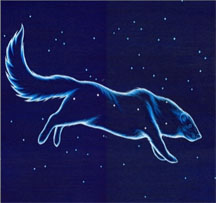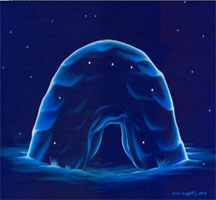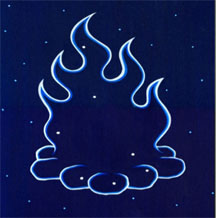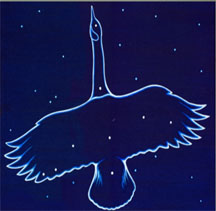Atchakosuk are the spirit lights up above. “All people of the Earth have stories of the stars. The First People of North America are no different” — Wilfred Buck, Cree Science Educator.
The late storyteller Murdo Scribe told this story of the big dipper: Ochek Atchakosuk are the fisher stars in Cree legends from Northern Manitoba. (The fisher is a small fierce relative of the wolverine.) This legend tells us how summer was brought to the north country. Long ago there was no summer in northern Manitoba. (This may be a living memory of ice ages.) Certain animals were selected to bring summer to the northern hemisphere. The Ochek, the fisher, was given this task and in honor of this, the Creator placed the fisher in the sky to remind the people of what “was”, what “is” and what “could be again if we do not respect what is loaned to us.”
In The Dog Star story, Atima Atchakosuk, Polaris is called Mahkan Atchakos, the wolf star. Long ago the people had no dogs to protect them. Their relatives the wolf, coyote, and fox saw this. The wolves held a council and decided that two of them would go to live with the people, as did the coyote’s and foxes’ councils. Two pups from each council were also sent to all the four directions of humankind. They adapted and were domesticated. From these four came all the dogs in the world, and now they guard our homes and camps. To honor this sacrifice by the natootim-uk (our relatives) the Creator placed a reminder in the heavens. Polaris anchors the leash as the dogs run around their sky camp. The three stars of the little dipper handle represent the wolf (Polaris), coyote, and fox. The four bowl stars represent the pups sent to the four directions of humankind.
In the Ininew language, Polaris is called Keewatin Atchakos, the going home star. If First Nation people kept Keewatin on their right shoulder while traveling at night, they knew they were traveling west. The Plains Cree called Polaris the standing still star, Ekakatchet Atchakos.
Corona Borealis, the Northern Crown, is significant in many First Nation sky stories. Some First Nation legends see the half circle as Matootisan, the Sweat Lodge. The legend tells the tale of Assini Awasis, Stonechild and how he brought the Sweat Lodge to the people. He was instructed to build a domed lodge over the rocks which hold the spirit of the night. When heated, the spirits in the rocks are released. The Pleiades are Matootisan Assiniuk, the sweat lodge rocks and Polaris is the Altar. Sometimes all three can be seen in the sky at once and this reminds us where to go for comfort, hope, and healing.
In Cree, the Milky Way is called Neepin Pinesisuk Meskinaw, the summer birds path. Niska the goose or Wahpasiw the swan (the constellation Cygnus) and other birds follow this path when they migrate south and back north. In Ojibway this is Pinesi Miikana, the Thunder Bird’s Path. Other stories call it the Wolves Road and others call it “maskinaw atchakuk,” the path of souls.
I learned these stories from Wilfred Buck, a science educator with the Manitoba First Nations Education Resource Centre. Wilfred was a speaker at the North York Astronomical Association’s 2009 Starfest in Ontario Canada in August. He told these and many other First Nation astronomy stories to a captivated audience, including me. Wilfred is from the Opaskwayak Cree Nation of Northern Manitoba. He has a bachelors and post-baccalaureate degree from the University of Manitoba and has 15 years experience as an educator.
At dusk, we all stepped outside and Wilfred conducted a First Nation Sky Tour. He talked about his life and told stories of his own past. When the first stars came out he conducted a Cree sky tour with a green laser pointer to a large circle of listeners.
Now, when I look up to see the constellations in the northern sky, I imagine the views of untold storytellers long gone. I wish they could have passed their stories on. There are many more First Nation stories about the stars, and they will reveal themselves to special people who seek these stories, like Wilfred Buck.
As one elder stated, “We are blessed to live under a blanket of stars.”
Special acknowledgement to artist Edwin Bighetty from Mathias
Colomb First Nation for the painted pictures of
1. Ochek Atchakosuk (Big Dipper)
2. Atima Atchakosuk (Little Dipper)
3. Matootisan (Corona Borealis)
4. Matootisan Asiniuk (Pleiades)
5. Niska (Cygnus)





What a wonderful new sky chart of the heavens. Viewing the stars and the constellations in this new way reminds us anew that “we are blessed to live under a blanket of stars”.
Cool site im using it to get info for my in school class asignment keep up the good work
Awesome! There are more Cree legends. I hope to write up another one soon! Jane
[...] crystals and tossed them in the sky. And that is how the Milky Way was created. You can see the big dipper stars in the web of the dreamcatcher. The handle star, Alkaid is near the top of the dreamcatcher , and [...]
Awesome website! Thank you for this rich information which I will share with several grade 3 classes on Aboriginal Astronom
Meegweetch
Thanks and really glad you like it!!! I’ll be at the Manitoba First Nation Education Resource Centre’s Science Fair in Winnipeg in April. And have another star story from my November 2010 trip to Manitoba. Here’s the link http://jane.whiteoaks.com/2011/01/30/a-dreamcatcher-and-a-blanket-of-stars/
I’m using some of these names in my student learning guides in math class. I work in a first nation school, so this has been very useful.
Thamks for the wonderful stories. My grandmother used to tell us stories when we were children. She shared about the Cree Creation story. Cih cip sci kwan (rolling head). In this story the North Star came form the first man, Tawaham, and the big dipper was the first woman Cih cip scik wan. I love hearing our astronomy. Keep up the good work.
[...] http://jane.whiteoaks.com/2009/10/13/first-nations-astronomy-seeing-the-ininewuk-cree-and-ojibway-sk… [...]
[...] more information please go to: http://jane.whiteoaks.com/2009/10/13/first-nations-astronomy-seeing-the-ininewuk-cree-and-ojibway-sk… 0 [...]
[...] First Nations used stars to find their way, determine a sense of time, and associated the constellations in their stories. This is a link to a First Nations Star Chart. Astronomer, Jane Houston Jones, shares Cree and Ojibway sky stories here. [...]
thank you so much. I heard of these First Nations’ legends, from CBC of course, a First Nations’ program, which name I have forgotten, and want to use this in the new BC curriculum which integrates all learning now, with First Nations’ knowledge. Very exciting